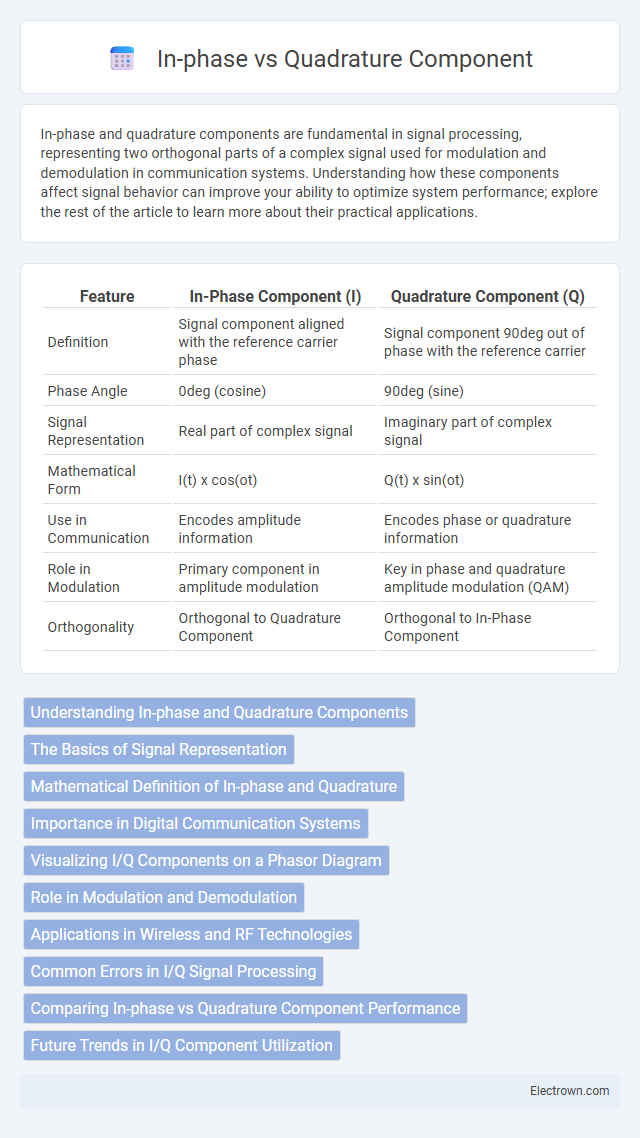In-phase and quadrature components are fundamental in signal processing, representing two orthogonal parts of a complex signal used for modulation and demodulation in communication systems. Understanding how these components affect signal behavior can improve your ability to optimize system performance; explore the rest of the article to learn more about their practical applications.
Table of Comparison
| Feature | In-Phase Component (I) | Quadrature Component (Q) |
|---|---|---|
| Definition | Signal component aligned with the reference carrier phase | Signal component 90deg out of phase with the reference carrier |
| Phase Angle | 0deg (cosine) | 90deg (sine) |
| Signal Representation | Real part of complex signal | Imaginary part of complex signal |
| Mathematical Form | I(t) x cos(ot) | Q(t) x sin(ot) |
| Use in Communication | Encodes amplitude information | Encodes phase or quadrature information |
| Role in Modulation | Primary component in amplitude modulation | Key in phase and quadrature amplitude modulation (QAM) |
| Orthogonality | Orthogonal to Quadrature Component | Orthogonal to In-Phase Component |
Understanding In-phase and Quadrature Components
In-phase (I) and Quadrature (Q) components represent two orthogonal signals used to convey information in complex modulation schemes such as QAM and QPSK. The In-phase component aligns with the original carrier wave, while the Quadrature component is shifted by 90 degrees, allowing simultaneous transmission of data on both channels. Understanding Your system's I and Q components enhances signal processing accuracy and improves communication quality.
The Basics of Signal Representation
In signal representation, the in-phase (I) component corresponds to the real part of the signal, while the quadrature (Q) component corresponds to the imaginary part, providing a complete description of a complex waveform. These components enable the analysis and processing of signals in communications by representing amplitude and phase variations efficiently. Your ability to manipulate both I and Q components is essential for accurate modulation and demodulation in modern digital communication systems.
Mathematical Definition of In-phase and Quadrature
The in-phase (I) and quadrature (Q) components represent the orthogonal projections of a complex signal onto cosine and sine basis functions, respectively, mathematically defined as \( I = A \cos(\theta) \) and \( Q = A \sin(\theta) \), where \(A\) is amplitude and \(\theta\) is phase angle. These components form the real and imaginary parts of a complex phasor \(I + jQ\), enabling precise representation and manipulation of modulated signals in communication systems. Understanding your signal's I and Q values allows you to perform accurate demodulation and analysis in both time and frequency domains.
Importance in Digital Communication Systems
In-phase (I) and Quadrature (Q) components are critical in digital communication systems as they enable efficient modulation schemes like QAM and PSK, which improve bandwidth utilization and error performance. These components represent orthogonal signals allowing simultaneous transmission of multiple bits per symbol, enhancing data rates without increasing bandwidth. Accurate separation and processing of I and Q components are essential for minimizing signal distortion and achieving reliable digital communication.
Visualizing I/Q Components on a Phasor Diagram
Visualizing I/Q components on a phasor diagram involves representing the in-phase (I) component along the horizontal axis and the quadrature (Q) component along the vertical axis, forming a vector that describes the signal's amplitude and phase. This vector's length corresponds to the signal magnitude, while its angle reflects the instantaneous phase relative to a reference. Phasor diagrams provide intuitive insight into complex modulation schemes such as QAM and PSK by illustrating how I and Q components combine to convey information.
Role in Modulation and Demodulation
In-phase (I) and Quadrature (Q) components play a crucial role in modulation and demodulation by enabling the representation of complex signals through orthogonal carriers, improving spectral efficiency and data rates. Your communication system uses these components to separate and process signals independently, allowing for effective encoding and decoding of data in schemes like QAM and QPSK. Accurate recovery of I and Q phases ensures minimal interference and optimal signal integrity during transmission and reception.
Applications in Wireless and RF Technologies
In-phase (I) and Quadrature (Q) components are fundamental in wireless and RF communication systems for modulating and demodulating signals, enabling efficient transmission of data through amplitude and phase variations. Your ability to accurately process I/Q signals directly impacts the performance of technologies like MIMO, radar, and software-defined radio by improving signal clarity and reducing interference. These components facilitate advanced modulation schemes such as QAM and QPSK, which are essential for high-speed data transmission in modern cellular networks and satellite communications.
Common Errors in I/Q Signal Processing
Common errors in I/Q signal processing often stem from imbalances such as amplitude mismatch and phase error between the in-phase (I) and quadrature (Q) components, leading to signal distortion and spectral leakage. Imperfect gain or phase calibration can cause image frequency interference, degrading overall system performance in communication receivers. To optimize Your signal integrity, precise calibration and compensation algorithms must be employed to minimize these I/Q distortions.
Comparing In-phase vs Quadrature Component Performance
The in-phase (I) component carries the primary signal amplitude, while the quadrature (Q) component represents the signal phase shift, both crucial for accurate signal demodulation in communication systems. Performance comparison reveals that I component is often less susceptible to phase noise, whereas the Q component enhances signal robustness by enabling complex modulation schemes such as QAM. Your communication system's efficiency depends on optimizing the balance between these components to improve error rates and overall signal fidelity.
Future Trends in I/Q Component Utilization
Future trends in I/Q component utilization emphasize advanced modulation schemes like 5G NR and beyond, leveraging high-order QAM to enhance spectral efficiency and data rates. Emerging technologies integrate AI-driven signal processing to optimize phase and amplitude alignment, reducing distortions in complex communication environments. Innovations in software-defined radio and massive MIMO architectures enable dynamic manipulation of I/Q components for improved signal integrity and adaptive beamforming capabilities.
In-phase vs Quadrature Component Infographic

 electrown.com
electrown.com